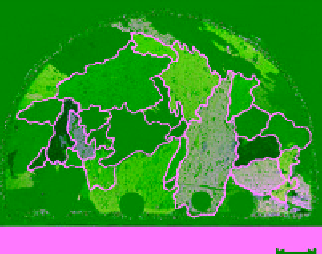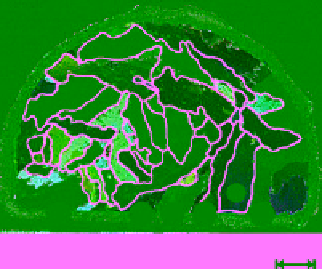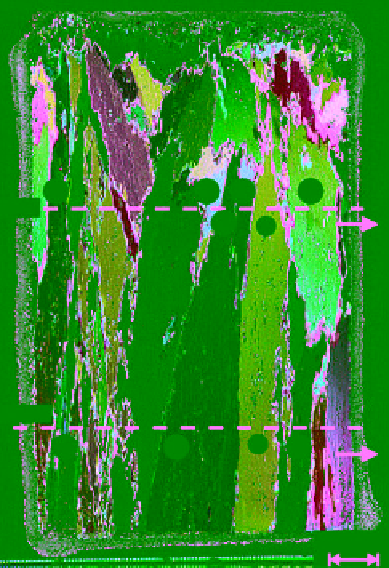Geology Reference
In-Depth Information
(a)
(b)
g6
g4
g2
g1
5
4 cm
g6
g4
g3
g2
g1
g3
5
10 mm
(c)
10 cm
g8
g3
g7
5
5
g8
g3
g7
10 mm
10 mm
Figure 4.47
Photographs of (a) vertical thin section of FY ice and (b) and (c) two horizontal sections obtained at
the two depths marked by the dash lines in the vertical section. The crystal boundaries in the horizontal sections
are delineated manually. Grains (crystals) are designated in all sections as g1, g2, …, g8 [
Johnston,
1998].
well‐defined columnar ice starting immediately under the
surface. Grain boundaries were delineated manually in
the digitized photographs on the horizontal thin sections
as shown in Figure 4.47. Grains in both the horizontal
and vertical planes are designated g1, g2, …, g8. Their
locations in the vertical sections indicate that grains g1,
g2, and g4 are eliminated before they can form well‐estab-
lished columns. This is also confirmed by their absence
from horizontal section at a depth of 100 mm. Grain g5
persists throughout the vertical growth while other grains
persist but only to certain depths.
As mentioned before, site 2 of the ice cover in the Allen
Bay (Figure 4.33) had small SY ice floes in the spring of
1997. A core from this ice was extracted and the age of
the ice was confirmed by examining the microstructure
and the salinity. The columnar grains that extended from
the surface terminated abruptly at a depth of 33 cm, after
which short columns (about 0.5-3 cm in length) existed.
The ice salinity was very close to zero throughout the
first 30 cm, then increased immediately to 6‰. These fea-
tures resemble the condition of new ice accretion under
the surface of SY ice, which is described in details in sec-
tion 5.1. For the purpose of this section, statistics of the
mean areas of grains and subgrains along with the length
of their major and minor axes are presented in Figure 4.48
for the SY ice (i.e., the top part of the ice cover). The area
of the grains spans 560 mm
2
, with most of the grains hav-
ing an area less than 150 mm
2
. In comparison, subgrains
are much smaller with a majority having an area less
than 50 mm
2
. The mean areas of the grains and subgrains
are 86 and 15 mm
2
, respectively. The major axis length of
the grains is roughly twice that of the subgrains but the
reverse is true for the minor axis. This means that grains
tend to be elongated but subgrains are mostly isotropic
in shape.
It is worth concluding this part by noting a pioneering
work presented in
Perovich and Gow
[1991] on digital
analysis of thin sections of polycrystalline saline thin ice
grown in an outdoor tank at the Cold Regions Research
and Engineering Laboratory (CRREL). It produced the
first geometrical characterization of ice crystalline
structure and statistical characterization of the spatial
variation of permittivity. The latter was obtained from
statistics of brine inclusions. The work was motivated by
the needs of microwave scattering modelers to parame-
terize the permittivity in order to calculate volume scat-
tering [
Tsang and Kong,
1981;
Winebrenner et al.,
1989].
The approach used by
Perovich and Gow
[1991]



